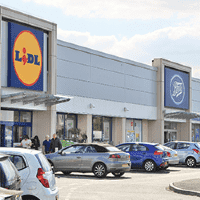The Aldi business model is to maintain the highest quality products at the lowest possible price. Their inventory is traditionally sparser than the tens of thousands of items that larger grocery chains and superstores have on hand any day of the week. However what the Value grocery outlet lacks in variety it makes up for in low prices, their success due in part to the low cost of their privately owned, off-brand items, which provides the bulk of what they offer.
Adhering to a high quality low price principle has led to growing footfall and has now allowed the grocer to move into more upmarket product sectors, appealing to a wider demographic and making it an even more attractive option for landlords. In January 2017 Aldi overtook Co-op as the fifth largest supermarket in the UK, according to analysis by Kanter Worldpanel. By August 2017 the grocer held a 7pc share of the market, up from 6.2pc the same time last year, compared to Co-op’s 6.3pc. The shift means that only the so-called ‘big four’ supermarkets (Tesco, Sainsbury’s, Asda and Morrisons) hold a greater market share than the Value grocery retailer.
There has been a shift in brand perception by the consumer which has subsequently led to a change in attitude towards these brands from occupiers, landlords and developers alike. The story is not exclusive to Aldi. Lidl have a similar promise with its ‘Big on quality, Lidl on price’ philosophy. Their growth in the UK grocery market has been just as impressive, now just behind Co-op with 5.2pc of the market, up from 4.5pc in August last year.
Value operators from all sectors share the principle that quality essential everyday shopping need not cost the earth. TK Maxx’s tagline ‘Big Labels, Small Prices’, highlights this. Other examples include B&M, ‘More Than A Bargain’ and Home Bargains ‘Top Brands, Bottom Prices’. All these retailers are suggesting they are able to offer quality at a low price, which they equate to a number of practices from bulk buying and economical packaging of products to a more efficient supply chain and transportation methods. Primark even state on their website that one of the ways they pass savings onto their customer is by doing very little advertising.
As the psyche of the UK consumer across all demographic groups has increasingly become one of getting value for money, the value element of retail parks will continue to be prominent; according to Global Data, Primark was stated by consumers as the most sought after retailer in 2017 in the OOT market (22.1%). The GFC almost certainly sparked the growth in the OOT Value market, across all sectors. However it is the change in attitude since then that has seen it continue to grow.
Value retailers have begun to locate in more affluent locations than has traditionally been the case, no longer exclusively pursuing less affluent demographic locations to serve their customer base, who have always been drawn by their competitive pricing. This is true for the grocery, fashion and the Comparison Goods market.
Since 2014, Value grocers for example have taken space in a number of affluent market towns including Brentwood, Canterbury, Chichester, Christchurch, Dewsbury, Harrogate, Melton Mowbray, Oxford, Wellingborough, York and Knutsford.
Analysing the surrounding catchments of all such additional OOT schemes containing a Value grocer, representing the growth between 2011 and 2017, as much as 21% of residents belong to the wealthiest ‘Affluent Achiever’ and ‘Rising Prosperity’ household categories in CACI’s Consumer Demographic Profile. These represent some of the most affluent people living in the UK, many of which can afford to spend freely and frequently or who certainly have a high disposable income.
.png)



.png)